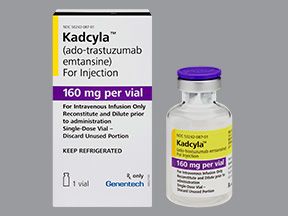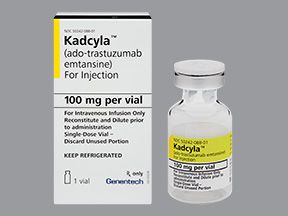Kadcyla (ado-trastuzumab emtansine) is a brand-name drug that’s prescribed for certain types of HER2-positive breast cancer in adults. Kadcyla comes as a solution for intravenous (IV) infusion that’s typically given by a healthcare professional.
Kadcyla is a biologic and belongs to a drug class called antibody-drug conjugates. Kadcyla is not available in a biosimilar version.
Keep reading for specific information about the dosage of Kadcyla, including its strengths and how to use the medication. For a comprehensive look at Kadcyla, see this article.
Note: This article describes typical dosages for Kadcyla provided by the drug’s manufacturer. However, your doctor will prescribe the Kadcyla dosage that’s right for you.
The dosage and administration of Kadcyla are the same whether the drug is prescribed for HER2-positive breast cancer that is early stage or metastatic. The term administration refers to how a drug is given.
Dosage summary
The following chart summarizes Kadcyla’s dosage for early stage and metastatic breast cancer. Milligrams and kilograms are abbreviated as mg and kg. 1 kg is about 2.2 pounds (lb). Your doctor will determine the dosage that’s best for you.
| Kadcyla form | Kadcyla strengths | Typical Kadcyla dosage | Maximum Kadcyla dosage |
| IV infusion | • 100 mg • 160 mg | 3.6 mg/kg once every 3 weeks | 3.6 mg/kg once every 3 weeks |
This article describes typical dosages for Kadcyla provided by the drug’s manufacturer below. However, your doctor will prescribe the Kadcyla dosage that’s right for you.
Kadcyla form
Kadcyla comes as powder in a vial. A healthcare professional will mix the drug with sterile water and give it to you as an intravenous (IV) infusion. You’ll receive Kadcyla in your doctor’s office, a clinic, or a hospital.
Kadcyla strengths
Kadcyla comes in two strengths: 100 milligrams (mg) and 160 mg.
Typical dosages
Here’s some information about the dosing regimen for Kadcyla. A regimen is a regulated course of treatment. The following describes dosages that are commonly used or recommended. Your doctor will determine the best dosage to fit your needs.
Dosage for adjuvant treatment of early breast cancer
The recommended dose of Kadcyla for early breast cancer is an IV infusion of 3.6 mg/kg of body weight. 1 kg equals about 2.2 lb. You’ll likely receive this dose once every 3 weeks (21 days).
Each 3-week period is considered to be a cycle. You’ll usually have a total of 14 cycles of treatment. If the cancer comes back or you’re unable to tolerate Kadcyla’s side effects, your doctor may stop your treatment.
Kadcyla is prescribed as an adjuvant therapy for early breast cancer. The goal of adjuvant therapy is to help prevent cancer from returning. Before you receive Kadcyla, you must have already taken a taxane chemotherapy drug and Herceptin (trastuzumab).
Dosage for treatment of metastatic breast cancer
The recommended dose of Kadcyla for metastatic breast cancer is an IV infusion of 3.6 mg/kg of body weight. You’ll likely receive this dose once every 3 weeks (21 days).
Each 3-week period is considered to be a cycle. You’ll usually continue treatment as long as the drug is safe and effective for you. If the cancer comes back or you’re unable to tolerate Kadcyla’s side effects, your doctor may stop your treatment.
Long-term treatment
Kadcyla is meant to be used as a long-term treatment. How long you receive the drug depends on the type of breast cancer you have and whether you develop serious side effects. It also depends on whether the cancer returns.
The Kadcyla dosage your doctor prescribes will depend on several factors. These include whether you have early stage breast cancer or metastatic breast cancer. Other factors include your body weight and whether you experience serious side effects with Kadcyla and need a dose reduction.
Other medical conditions you have can also affect your Kadcyla dosage.
Dosage adjustments
Your doctor may adjust your dosage of Kadcyla if you develop certain side effects, including:
- infusion-related reactions, such as swelling or pain
- low platelet count
- lung problems, such as pneumonitis (lung inflammation)
- problems with the nerves in your hands and feet
- a heart problem* called decreased left ventricular ejection fraction
- decreased liver function*
Depending on your situation, your doctor may decrease your dosage, or pause or stop your treatment.
* Kadcyla has boxed warnings about risks of severe heart and liver problems. Boxed warnings alert doctors and patients about drug effects that may be dangerous. To learn more, see “Boxed warnings” at the top of this article.
A healthcare professional will mix Kadcyla powder with sterile water to form a solution. They’ll give you the medication as an intravenous (IV) infusion. This is an injection into a vein over a period of time. You’ll likely receive the injection in your arm or the back of your hand.
To receive your Kadcyla infusions, you’ll go to your doctor’s office, a clinic, or a hospital. Your first dose will usually be given over 90 minutes. If you don’t have infusion-related reactions, such as swelling or pain, future infusions may last 30 minutes. This is because you’ll be able to receive the drug at a faster rate than before.
For more information about receiving Kadcyla, talk with your doctor.
If you miss an appointment for a Kadcyla infusion, talk with the staff at your doctor’s office right away. They’ll likely want to reschedule you as soon as possible.
You can keep track of your infusion appointments with a calendar or reminder on your phone.
The dosages in this article are typical dosages provided by the drug’s manufacturer. If your doctor recommends Kadcyla, they will prescribe the dosage that’s right for you.
If you have questions about your Kadcyla dosage, talk with your doctor.
Besides learning about dosage, you may want other information about Kadcyla. These additional articles might be helpful:
- More about Kadcyla. For information about other aspects of Kadcyla, refer to this article.
- Side effects: To learn about side effects of Kadcyla, see this article. You can also look at the Kadcyla prescribing information.
- Drug comparison. Find out how Kadcyla compares with Herceptin in this article.
- Details about breast cancer. For details about breast cancer, see our breast cancer hub and list of related articles.
Disclaimer: Medical News Today has made every effort to make certain that all information is factually correct, comprehensive, and up to date. However, this article should not be used as a substitute for the knowledge and expertise of a licensed healthcare professional. You should always consult your doctor or another healthcare professional before taking any medication. The drug information contained herein is subject to change and is not intended to cover all possible uses, directions, precautions, warnings, drug interactions, allergic reactions, or adverse effects. The absence of warnings or other information for a given drug does not indicate that the drug or drug combination is safe, effective, or appropriate for all patients or all specific uses.


